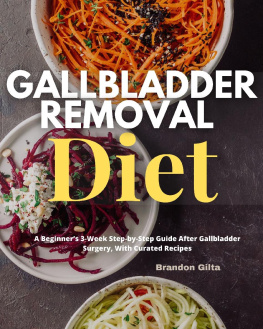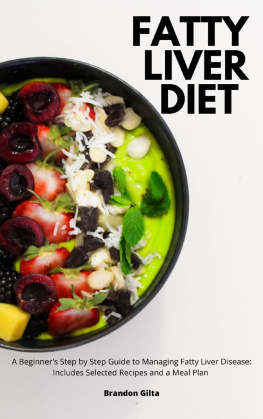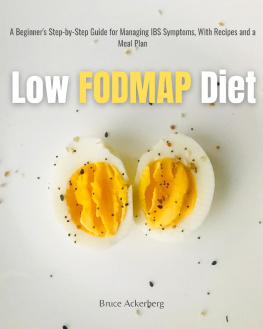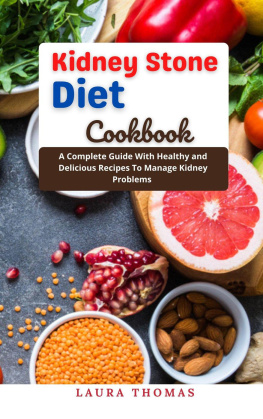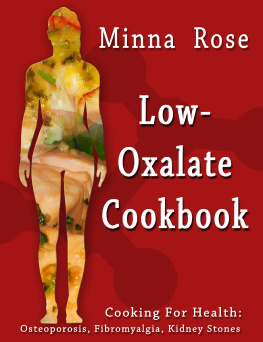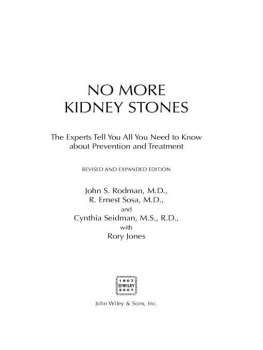Low Oxalate Diet
A Beginner's 3-Week Step-by-Step Guide for Managing Kidney Stones, With Curated Recipes, a Low Oxalate Food List, and a Sample Meal Plan
Copyright 2020 Brandon Gilta
All rights reserved. No portion of this book may be reproduced in any form without permission from the publisher, except as permitted by U.S. copyright law.
Disclaimer
By reading this disclaimer, you are accepting the terms of the disclaimer in full. If you disagree with this disclaimer, please do not read the guide. The content in this guide is provided for informational and educational purposes only.
This guide is not intended to be a substitute for the original work of this diet plan. At most, this guide is intended to be a beginner's supplement to the original work for this diet plan and never act as a direct substitute. This guide is an overview, review, and commentary on the facts of that diet plan.
All product names, diet plans, or names used in this guide are for identification purposes only and are the property of their respective owners. The use of these names does not imply endorsement. All other trademarks cited herein are the property of their respective owners.
None of the information in this guide should be accepted as independent medical or other professional advice.
The information in the guide has been compiled from various sources that are deemed reliable. It has been analyzed and summarized to the best of the Author's ability, knowledge, and belief. However, the Author cannot guarantee the accuracy and thus should not be held liable for any errors.
You acknowledge and agree that the Author of this guide will not be held liable for any damages, costs, expenses, resulting from the application of the information in this guide, whether directly or indirectly. You acknowledge and agree that you assume all risk and responsibility for any action you undertake in response to the information in this guide.
You acknowledge and agree that by continuing to read this guide, you will (where applicable, appropriate, or necessary) consult a qualified medical professional on this information. The information in this guide is not intended to be any sort of medical advice and should not be used in place of any medical advice by a licensed and qualified medical professional.
Always seek the advice of your physician or another qualified health provider with any issues or questions you might have regarding any sort of medical condition. Do not ever disregard any qualified professional medical advice or delay seeking that advice because of anything you have read in this guide.
Table of Contents
Introduction Chapter 1: Oxalates and Kidney Stones Chapter 2: Low Oxalate Diet Chapter 3: Food and Oxalate Chapter 4: Diet Meal Plan Week 1 Chapter 5: Diet Meal Plan Week 2 Chapter 6: Diet Meal Plan Week 3 Sample Curated Recipes Conclusion
Introduction
What do Louis XIV, Marin Luther King, Sir Isaac Newton, Caesar Augustus, Benjamin Franklin, and Oliver Cromwell have in common? Kidney stones. These famous people all suffered from kidney stones.
1 in every 10 individuals is estimated to have kidney stones once in their life. In the United States alone, the frequency of kidney stones rose from 3.8% in the 1970s to 8.8% in the 2000s. And in 2014, the frequency further increased to 10%. But kidney stone problems are not entirely a new problem.
Kidney stone removal is one of the earliest medical procedures recorded in history. In ancient India, around 600 BC, a physician named Sushruta described the process of bladder stone extraction through the perineum. It was around the 3 rd century that the process of breaking down the stones into smaller pieces was first introduced. History proves that the battle against kidney stones is as old as history itself.
Most medical practitioners agree that kidney problems are a silent pandemic. As many as 37 million adults in America suffer from kidney problems. What's worse is that they don't even know it until their kidneys started to fail. And when the kidneys fail, the body's normal function is also affected. One of the main culprits behind kidney problems is the formation of kidney stones. Chronic kidney stone formation may end as a bigger kidney problem if left untreated. And if you already had one, youll have more chances of developing another.
In the Low Oxalate Diet, youll discover:
- The right way to eat without getting worked up on kidney problems.
- How you can maintain a diet while eating the foods that you love.
- The importance of knowing what exactly your food is made up of.
- Why you need to be cautious of eating anything marketed as a healthy food.
- How you can increase longevity via kidney health
Chapter 1: Oxalates and Kidney Stones
Oxalates or Oxalic acid are naturally occurring acids present in most edible plants. Metabolism of Vitamin C can also synthesize oxalates. Oxalates are linked to reducing the absorption of minerals. For example, spinach is high in both calcium and oxalate. The oxalate in spinach lessens the body's absorption of calcium.
Oxalates are naturally expelled from the body. However, some factors affect how our body eliminates oxalate. A calcium-deficient diet lowers the elimination rate of oxalate. Consuming high oxalate foods can also increase the amount of oxalate in the body.
When present in excess, oxalates pose serious health problems. Oxalate often binds with other minerals to form stones. Oxalate compounds, usually iron oxalate and calcium oxalate, can be found in the gut and certain parts of the urinary tract.
Normally, the presence of oxalates compounds in the urine is not a health concern, given that they occur dissolved and in small amounts. However, oxalate compounds often bind together and then crystallize more to form stones. The resulting calcium oxalate stones can cause problems wherever they buildup. Untreated oxalate may result in kidney failure, anemia, eye, skin, and thyroid problems.
Kidney Stones
Kidneys are primarily known for their function in making urine by removing both the solid and fluid waste from the blood. However, if there is less fluid in the blood, the solid wastes form together to form kidney stones.
Types of Kidney Stones
1. Struvite stones struvite stones are associated with specific types of Urinary tract infection. It is composed of ammonium, magnesium, and phosphate. The stone form because the bacteria brought by the UTI triggers ammonia to clump together in the urine. 2. Cystine stones Cystine is a naturally produced chemical of the body. The formation of cystine stones are rare and happen only in people who have a genetic condition that allows cysteine to blend into the urine. 3. Uric acid stones Uric acid is naturally present in urine. Uric acid stone forms when there is not enough water in the body. Uric acid then binds with itself to form a stone. This then makes the urine more acidic. 4. Calcium Oxalate Stones Calcium oxalate stones are the most common types of kidney stones. Too much oxalate or too little fluid in the urine causes the oxalate to bind with calcium from stones. A diet rich in protein, oxalate, or sodium is the main reason for this type of kidney stone formation. Hyperparathyroidism, diabetes, and obesity are also the main causes of calcium oxalate stone formation.
Symptoms
1. Pain, pressure, or discomfort felt on the groin or the side of the abdomen, or in both
2. Blood in the urine
3. Urinary tract infection
4. Nausea and vomiting
5. An increase urge to urinate
6. If the infection is present, fever and chills


